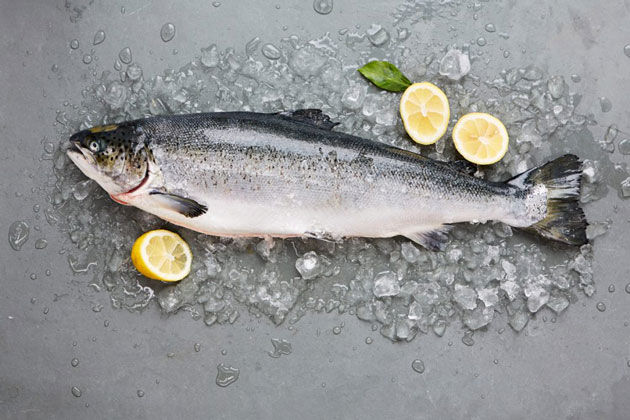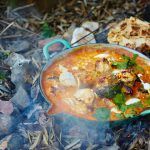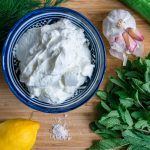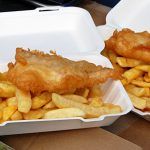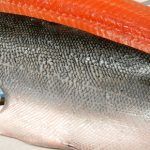Without a doubt, salmon is one of our favourite fish, and it’s not hard to see why – it’s easy to cook, incredibly versatile and totally delicious. We asked seafood expert Bart van Olphen to spill his secrets for creating show-stopping salmon dishes.
Salmon truly is a wonderful fish – its high oil content makes it smooth in texture and rich in flavour, plus it’s packed full of omega-3 and essential fatty acids which we all need to keep our blood cholesterol healthy, and vitamin B12, which aids psychological function. On top of all that, its mellow flavour makes for an easy introduction to fish for kids.
As well as giving you a bit of background info, I’m going to show you the top techniques you need to cook amazing salmon at home – from basic cooking skills, such as pan-frying, roasting, poaching and steaming – to making the perfect accompanying sauce.
FARMED ATLANTIC VS WILD PACIFIC

In general, we can divide salmon into Atlantic and Pacific categories. Many years ago, we could enjoy wild caught Atlantic salmon coming up the rivers from European countries such as Norway and Scotland. Unfortunately, our unlimited demand for salmon took its toll, and apart from some small-scale local activities, there are no commercial wild Atlantic salmon left. This forced us to start farming salmon, and now Norway, Scotland and Chile have big industries to match our enormous demand for this tasty seafood.
Wild Pacific salmon can still be found in areas such as Alaska, British Columbia and the Russian coast. Most of the wild salmon on the market is Alaskan, and is usually one of five species. Each of them has two specific names, one American and one Inuit:
- Chum or Keta
Relatively small fish, mainly lightly-pink coloured, frozen or tinned - Humpy or Pink
Colour is in the name, mainly used for the tinned market - Red or Sockeye
The meat is red-coloured, often used as fresh or smoked - Silver or Coho
Amazingly silver-coloured skin, often used as fresh or smoked - King or Chinook
The best of the best – a large fish
BUYING SALMON: WHICH CUT?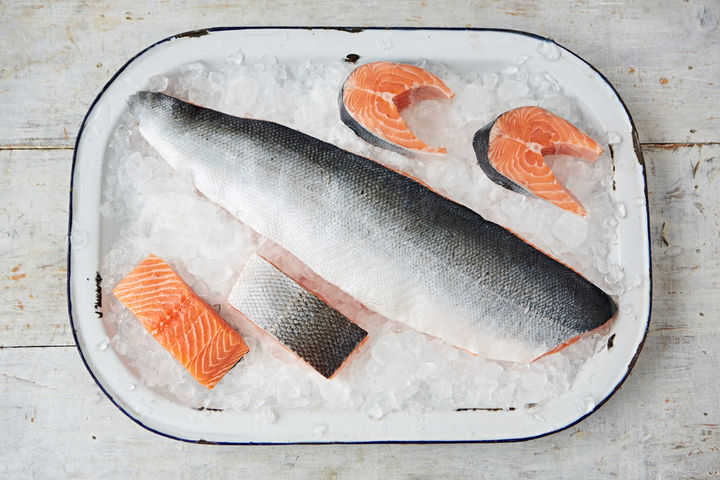
At any good fishmonger, you’ll have the choice between buying a whole salmon, or different cuts or fillets. If you opt to buy a whole salmon, make sure that the eyes are bright, the gills are red and the skin is vibrant and shiny.
Another option is to buy a whole fillet, which is a side of salmon. This can be more convenient if you’re not comfortable with working with a whole fish. The fish meat should shine and if it’s not pre-packed, give it a quick smell – it’s important to remember that fresh fish should be odourless.
Your final option is to buy pre-cut salmon fillets, which are offered pre-packed in the majority of supermarkets. Have a good look at the expiration date – fresh salmon is packed with a six to eight days’ shelf life.
SEASONALITY & SUSTAINABILITY
As with any meat or fish, it’s important to buy the most expensive you can afford. For salmon, this means buying fish sourced from organic farms where farmers allow the fish more space to grow, and feed them natural food without any antibiotics.
Farmed salmon is available all year through. The wild salmon season starts in May and ends in September, but you can buy it year-round in good-quality frozen portions and as smoked products.
When buying wild salmon, look out for the Marine Stewardship Council label, and if buying farmed salmon, Aquaculture Stewardship Council label. For a 100% natural farmed product, look out for a certified organic label.
COOKING SALMON
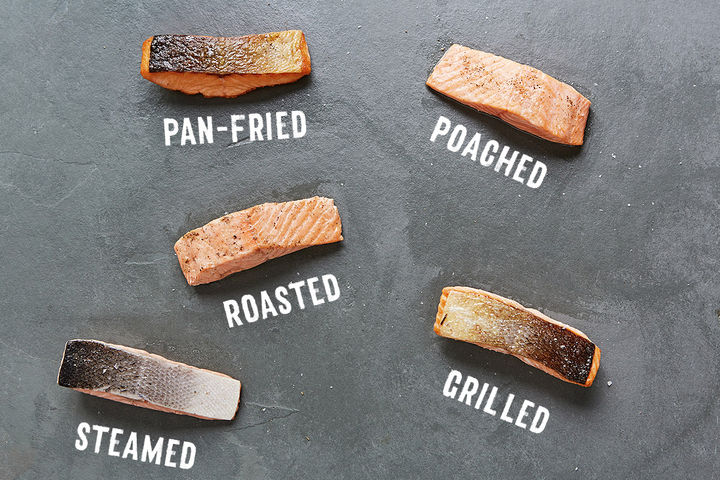
The great thing about salmon is that you can cook it in so many different ways. If you use fresh wild salmon, make sure it’s cooked properly and has reached a minimum core temperature of 60ºC/145ºF to ensure that any parasites are killed. If you use frozen wild salmon or smoked salmon, you don’t need to worry as much, as these preserving methods already assure the safety of consumption. If you want to eat raw salmon or make sushi or sashimi, farmed salmon is advised.
All of the cooking methods shown below are based on a medium cuisson – in other words, the fish is still tender and juicy inside. If you prefer it rarer, cook it for one to two minutes less, or if you’d rather it well done, cook it for a few minutes longer. Watch out for white drops or flakes coming out of the salmon – this is the protein starting to set, and is a sign that the salmon is starting to overcook and could become dry.
PAN-FRYING
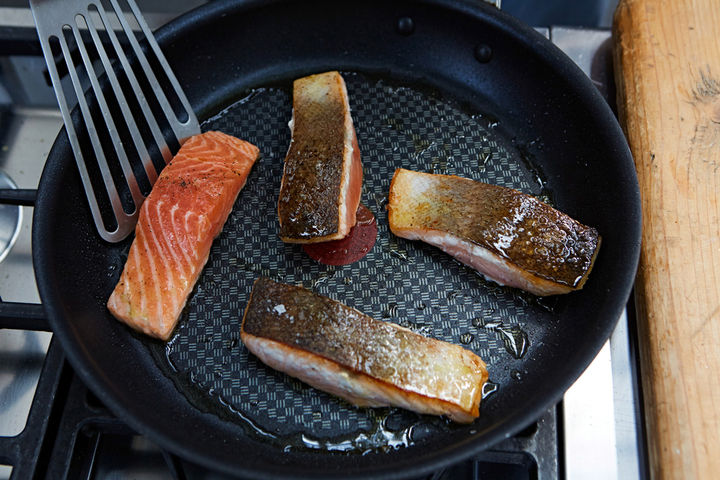
- Place a non-stick pan over a medium heat with 1 tablespoon of vegetable oil.
- Dab the salmon fillet or steak with a clean cloth or piece of kitchen paper to dry it slightly. Season with sea salt and black pepper, then place the salmon in the pan, skin-side down, for 2 to 3 minutes – you’ll see the colour become opaque from the bottom to the top, as the fish cooks.
- Turn the salmon over and cook for a further 1 minute for a lightly caramelised outside and tender, juicy inside (if your salmon fillet or steak is particularly big or small, use your common sense and adjust the timings accordingly).
Check out Jamie’s delicious sesame seared salmon with tahini avocado and zingy brown rice noodles.
GRILLING
- You can cook salmon under the grill, in a griddle pan or on the barbecue – start by getting your chosen grill nice and hot.
- Dab the salmon fillet or steak with a clean cloth or piece of kitchen paper to dry it slightly, then brush both sides with vegetable oil and season with sea salt and black pepper.
- If using your oven’s grill, cook for 10 minutes, depending on the thickness – there’s no need to turn the fish, but keep a close eye on it to make sure it doesn’t burn. If using a griddle pan or barbecue, grill on one side for 2 to 3 minutes, depending of the thickness, flip it over and repeat on the other side.
This gorgeous sticky, citrussy salmon with a chilli kick is perfect for testing your new grilling skills.
ROASTING
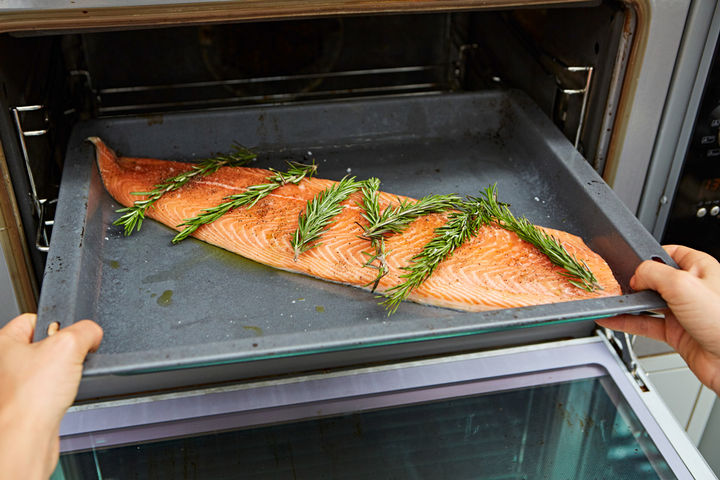
For a whole fish:
- Preheat the oven to 180ºC/350ºF/gas 4.
- If you’re cooking a whole gutted salmon, it’s great to stuff it with lovely flavours, so try adding stock, veggies, butter or herbs. Season generously and give it a good rub.
- As a guide, a 1.5 kilo salmon will need to be in the oven for 30 to 35 minutes, for it to be tender and juicy on the inside.
For a fillet or steak:
- Preheat the oven to 180ºC/350ºF/gas 4.
- Brush the salmon with vegetable oil, season and place it on top of a lightly-oiled oven tray.
- Bake the fish for 8 to 12 minutes, depending on the thickness.
For a simple yet delicious dinner, add a rainbow of veggies and some slices of lemon to your tray to bake along with your salmon, like in this roasted salmon & summer veg traybake.
POACHING
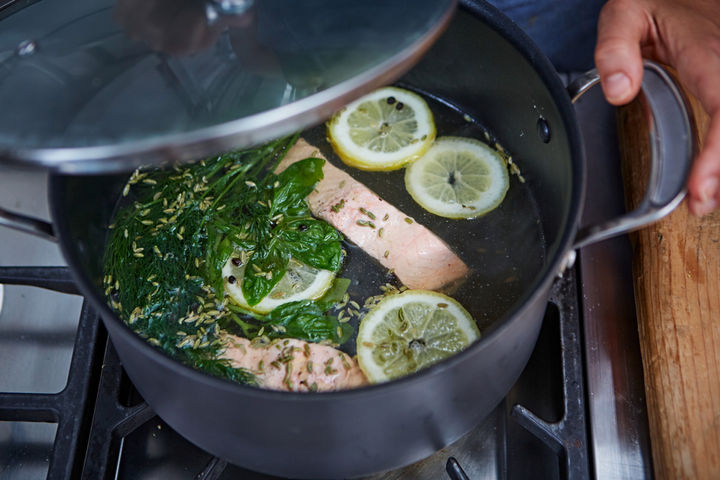
To give the salmon a good flavour, try using stock as your poaching liquid – both fish and vegetable stock work perfectly, but you can use chicken stock if it’s all you’ve got in.
- Start by seasoning the salmon fillet or steak well with sea salt and black pepper.
- Pour a bit of cold stock into a saucepan and lower the piece of salmon into it – this will help prevent the salmon sticking to the pan.
- Gently pour in the rest of the stock, up to 1 to 2cm above the fish. Cook on a medium heat, until the stock reaches just below boiling point, for 8 to 10 minutes, depending on the thickness.
This warm salmon and jersey royal salad is perfect with poached salmon.
STEAMING

With this technique you are not using the liquid itself, but the steam coming off it. Don’t worry if you don’t have a steamer – this technique works just as well with saucepan and a colander.
- Put a shallow layer of stock, wine or water in a pan and bring it to just under boiling point on a medium heat.
- Place a colander above the liquid, but not submerged, and place the salmon fillet or steak in. Cover with the saucepan lid so the steam can’t escape.
- Steam for 12 to 15 minutes, depending on the thickness.
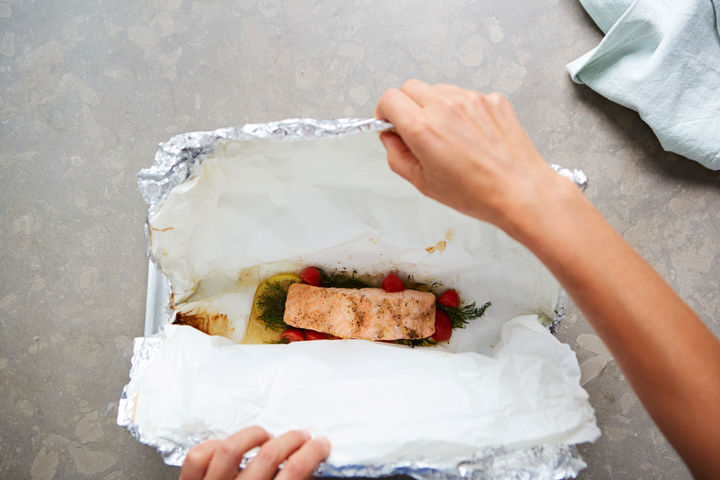
Another way to steam salmon is ‘en papillote’ – which means steaming the fish in a foil bag.
- Create a little pocket using tin foil and place the salmon fillet or steak into it, then add veggies, herbs, stock, water or wine.
- Seal the package making sure to leave enough space for the steam to flow around.
- Preheat the oven to 180ºC/350ºF/gas 4, then cook the fish for 10 to 12 minutes, depending on the thickness.
One of our favourite recipes is this super speedy steamed salmon, or let our easy step-by-step feature guide you through the foil bag approach.
SUPER SAUCES
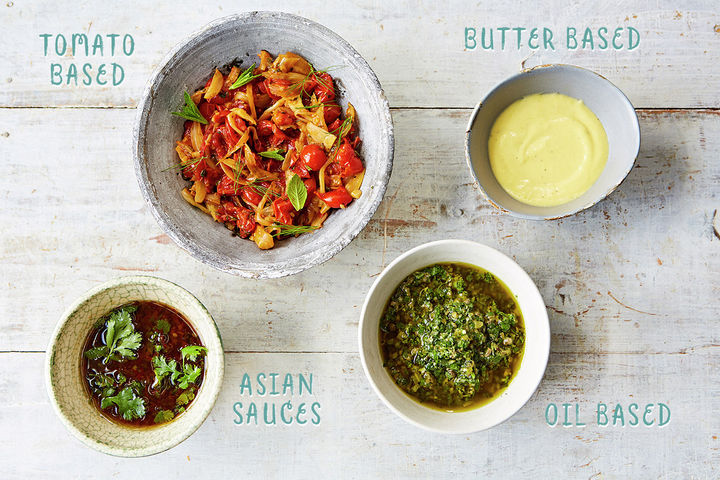
Once you’ve mastered the art of cooking salmon to perfection, all that’s left is to make a super sauce to go with it.
BUTTER-BASED
Butter is a fantastic base for salmon – think herb, sundried tomato, garlic or saffron flavours, plus the classics, such as hollandaise or beurre blanc.
For the latter two, I like to start by reducing vinegar. For hollandaise, I then gradually add in egg yolk and melted butter, or for beurre blanc, I slowly add very cold knobs of butter to the reduced vinegar while whisking. Neither of these sauces are the healthiest of options, but great for special occasions!
OIL-BASED
Oil-based sauces or dips go very well with salmon. For a simple salsa verde, just add delicious green herbs, capers and some vinegar to olive oil and blitz in a blender. You can add all sorts of flavours to an olive oil base, such as shallot, basil, capers, lemon, lime and garlic.
For a more Asian-style fish, a famous sauce is the sambal. Use coconut or vegetable oil for the base and combine with chilli, garlic and shallots.
TOMATO-BASED
Tomato-based sauces aren’t just for pasta! Sauces such as arrabbiata go great with salmon, too.
In the South of France, antiboise is a popular sauce to serve with seafood dishes. Antiboise is a base of olive oil, shallot and garlic, with added diced tomato, olives, capers, parsley and lemon. Traditional, but extraordinary with pan-fried or roasted fish.
ASIAN SAUCES
In my opinion, Asian sauces are the best with seafood. Who doesn’t love a smooth teriyaki with salmon? This sauce, based on soy sauce, sake, sugar or honey and mirin is often used as a glaze on top of the salmon, and when you cook with it, it caramelises and goes all sticky and delicious.
A classic ponzu sauce, based on soy sauce, dashi, rice vinegar and citrus is a favourite for seafood, too.
So there you have it! Our ultimate guide to salmon with fish expert Bart van Olphen. Check out more delicious salmon recipes or if you’re ready for the next step, why not learn how to fillet your own fish from scratch?
